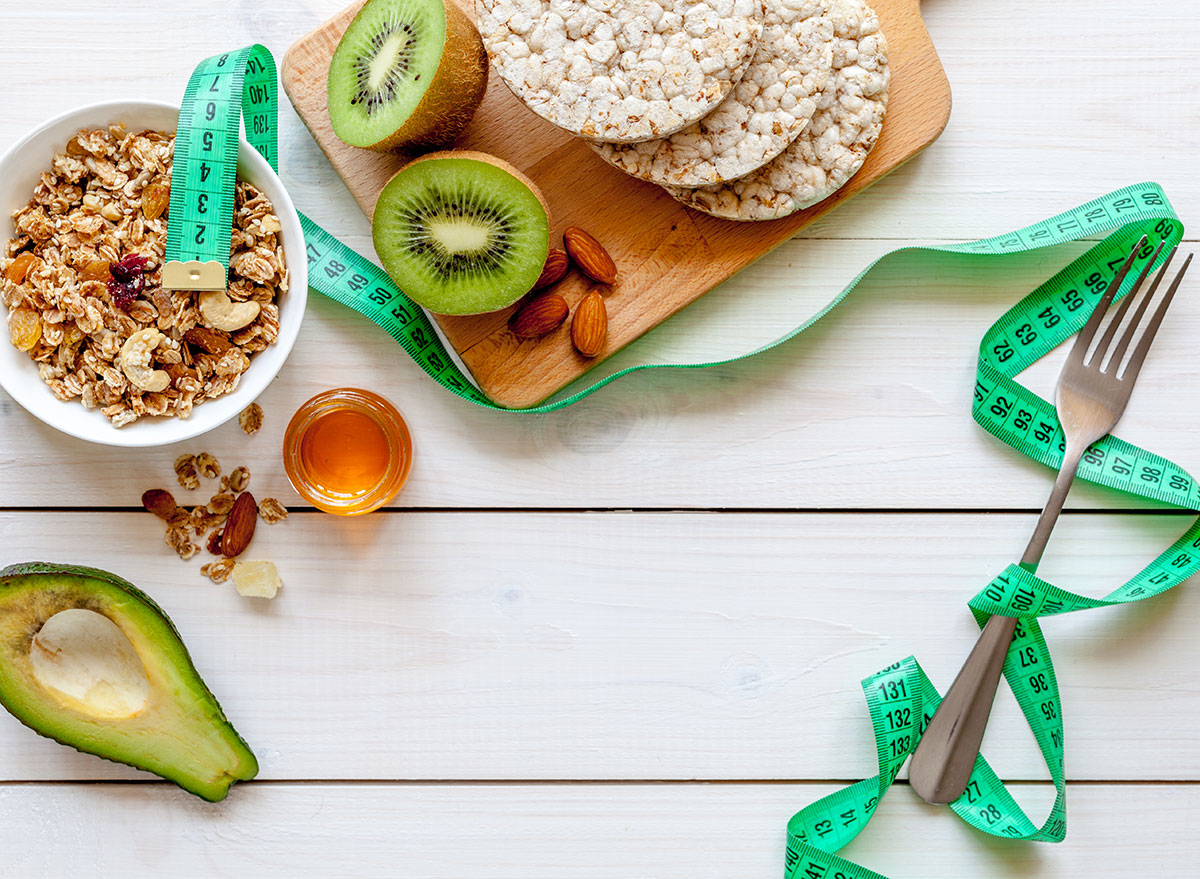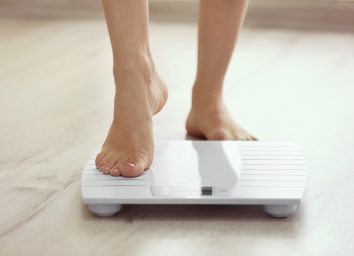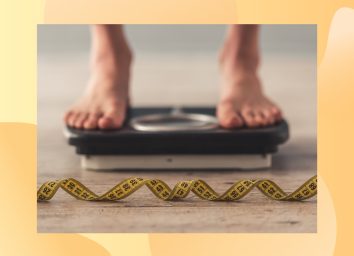Can the Optavia Diet Help With Weight Loss? Experts Share If the Mini Meals Work

Once upon a time in the ’80s, a diet plan called Medifast hit the market with packaged foods for weight loss. These mail-order shakes and bars were intended to replace breakfast and lunch, making weight loss a no-brainer. Today, though Medifast is still in operation, it has a number of popular subsidiaries that operate on the same principle of pre-selected meal replacements for weight loss. One of them is the Optavia diet, which was previously known as Take Shape for Life.
The Optavia diet appeals to dieters with its extreme convenience. (After all, it doesn’t get much easier than having your meals mailed to your door!) Plus, its easy-to-follow structure takes the guesswork out of meal planning. But does it actually work for weight loss? We talked to dietitians for their take on whether Optavia is a smart choice for shedding pounds.
The theory behind the Optavia diet.
Optavia’s tagline is “Lifelong Transformation, One Healthy Habit at a Time.” The Optavia diet’s primary focus is a diet based on multiple mini-meals (called “fuelings”) eaten throughout the day, complemented with one home-cooked meal (called “lean and green”).
The program is built around six “key building blocks” of optimal health:
- weight management
- eating and hydration
- motion
- sleep
- mind
- surroundings
The theory goes that if you have a plan to follow and prescribed mini-meals to eat, you’re less likely to stray into unhealthy eating territory. And when you only eat the limited number of calories the diet provides—sometimes as low as 1,100 calories per day—weight loss is near-guaranteed.
Additionally, by prepping your own “lean and green” dinner each night, healthy home cooking becomes a habit, making the transition from the diet back to “regular” healthy eating easier.
Optavia also offers a social support component that distinguishes it from many other meal replacement diets. Since emotional support is a major factor in weight loss success, those who enroll in its programs have access to a coach—typically someone who has successfully completed the program. This mentor can answer questions, provide education, and serve as a cheerleader for your weight loss journey.
How do you follow the Optavia Diet?
The day-to-day experience on Optavia involves eating multiple small meal replacements every two to three hours. These “fuelings” consist of over 50 options of low-calorie pre-packaged items like shakes, bars, brownies, soups, and other snack-like meals ordered directly from the company.
Depending on the Optavia program you choose, fuelings will make up anywhere from three to five of your six small daily meals. All fuelings are engineered to contain approximately the same balance of nutrients, so it’s up to you to choose which ones you’d like to eat on any given day and at any meal.
Your remaining meal (usually dinner) you’ll make yourself. Optavia calls this your “lean and green” meal and provides guidelines for making it with optimum ingredients for weight loss. A typical lean and green meal is made up of five to seven ounces of lean protein, three servings of non-starchy vegetables, and up to two servings of healthy fats.
Depending on your goals, you can choose from Optavia’s three different diet plans.
- The “4 & 2 & 1” plan involves four fuelings, two lean and green meals, and one healthy snack.
- The “3 & 3” plan is comprised of three fuelings and three “balanced meals.”
- Its most popular option, the “5 & 1,” is the strictest, with five meal replacements and one lean and green meal. If you start on the 5 & 1 plan, you can use either or both of the other plans to gradually wean off of meal replacements.
What foods are and are not allowed?
Since meal replacements make up most of your daily meals on Optavia, many of your food choices are more or less made for you. However, certain foods are definitely emphasized, while others are discouraged.
Foods to avoid while following Optavia.
Not surprisingly, indulgent items like high-calorie desserts, alcohol, and sugary drinks don’t make the cut at any stage of Optavia’s plans.
Other foods may be limited at first, then gradually reintroduced as you meet your weight loss goals. These include starchy vegetables, fresh fruit, grains, and low-fat dairy.
Foods to eat on Optavia.
When creating your lean and green meals, your meal planning toolbox consists of lean protein, vegetables, and healthy fats. Optavia lists options of “lean,” “leaner,” and “leanest” meats and plant-based proteins that range from egg whites to steak. Portion sizes of these protein sources depend on their leanness.
As for the three servings of veggies allowed at this meal, you can choose from lower-carb, moderate-carb, and higher-carb options—anything from iceberg lettuce to spaghetti squash.
Finish things off with a healthy fat like olive oil, avocado, or low-carb salad dressing to add a bit of flavor.
The risks and benefits
The extremely low-calorie nature of Optavia comes with pros and cons. Even though weight loss isn’t always as simple as calories-in versus calories-out, 1,100 calories is a significant slash from what most of us consume on a regular day—so you are likely to lose weight quickly upfront, especially on the 5 & 1 plan. “Any time you eat low-calorie, you will see results in the beginning,” says dietitian Brittany Modell, MS, RD, CDN.
But as for keeping it off? There’s the challenge. “Our bodies are very smart, over time they will compensate for your low-calorie diet by going into ‘starvation mode,'” Modell says. “When you lose more than two pounds per week, you might start to tap into your lean muscle mass rather than fat.” Plus, even though you schedule fuelings every couple of hours, you may still find yourself hungry on the diet.
Other pitfalls of Optavia include boredom and feelings of social isolation. “I think a meal replacement diet can be a start to strategizing your weekly meals, but it can create a challenge with the monotony,” says Tony Castillo, MS, RDN, LDN, a spokesperson for RSP Nutrition. (Besides, there’s no denying it’s tough to choose a granola bar when your pals are hitting happy hour.)
Optavia’s fuelings aren’t exactly inexpensive, either. Prepare yourself for a financial investment if you opt for this diet. Four weeks of meal replacements range from $400 to $450.
One Optavia benefit is its built-in coaching feature. The diet offers a helpful support system that can help users stick with their weight loss goals. For people who need structure, fuelings eliminate the question of what to eat and when. And the packaging and portability of these grab-and-go mini-meals offers total convenience for busy days.
Do dietitians recommend it?
While going on Optavia may help you drop weight fast, many dietitians aren’t big fans. Castillo notes that although the diet could jumpstart weight loss, it’s probably not a long-term solution. “Meal replacement doesn’t work in the long run because you have to rely on prepackaged processed meals and snacks. Instead, try finding a plan that best aligns with your needs so you can get the results you want.”
Modell agrees. “My best piece of advice would be to not use meal replacements,” she says. “However, if you are already using them, I recommend adding some unprocessed, wholesome foods back into your diet such as fruits and vegetables. Eating balanced meals is important.”








